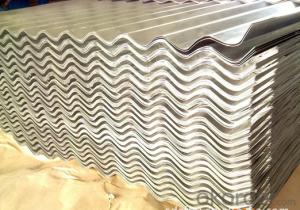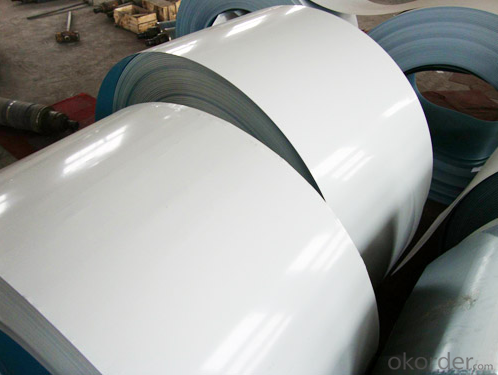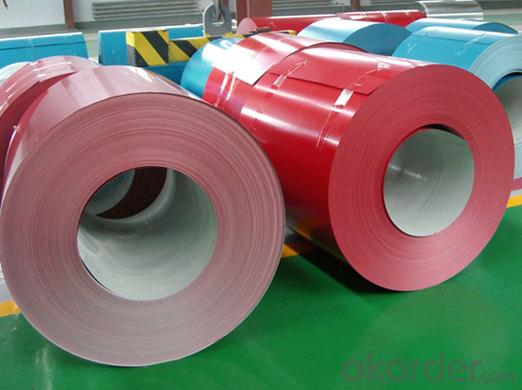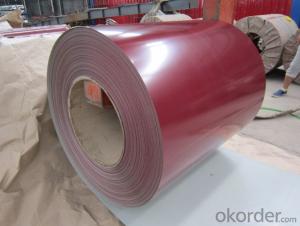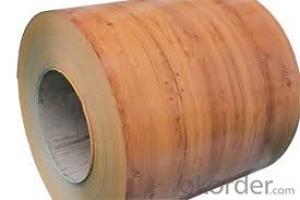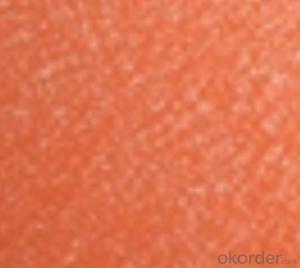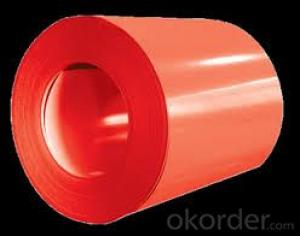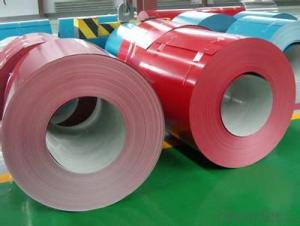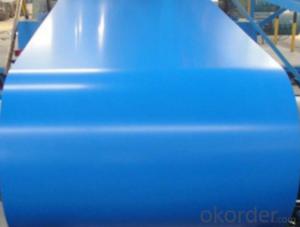Pre-Painted Color Coated Galvanized Steel Coils/Sheet
- Loading Port:
- China main port
- Payment Terms:
- TT OR LC
- Min Order Qty:
- 25 m.t.
- Supply Capability:
- 100000 m.t./month
OKorder Service Pledge
OKorder Financial Service
You Might Also Like
Pre-Painted Color Coated Galvanized Steel Coils/PPGI
Product Description
Prepainted Galvanized Steel Coil PPGI Steel Coil
1) Quality standard of Prepainted Galvanized Steel Coils: JIS G3312 CGCC & CGLCC
2) Grade of Prepainted Galvanized Steel Coils: CGCC and CGLCC
3) Hardness of Prepainted Galvanized Steel Coils: Both soft and hard quality are available
4) Surface finish of Prepainted Galvanized Steel Coils: With or without protect film
5) Thickness of Prepainted Galvanized Steel Coils: 0.14-1.20 mm
6) Width of Prepainted Galvanized Steel Coils: 914mm, 1000mm, 1220mm and 1250mm, width 600-1250mm is available
7) Finish by coil or sheet for Prepainted Galvanized Steel Coils: Both sheet and coil are available
8) Zinc coating of Prepainted Galvanized Steel Coils: 60-275G/M2, both sides
9) Paint thickness for top side of Pre-painted Galvanized Steel Coils: 5 micron primer + (10-20) microns modified polyester, any RAL color code.
10) Paint thickness for back side of Pre-painted Galvanized Steel Coils: (5-10) microns Epoxy
11) Weight per Pre-painted Galvanized Steel Coils: 4-6 tons, also can be upon customer's requirements
12) Max loading weight in one 20ft container for Pre-painted Galvanized Steel Coils: 25 tons generally
13) MOQ of prepainted steel coils: 25 tons for each item;
14) Actual shipping quantity of Pre-painted Galvanized Steel Coils: More or less 10% generally;
15) Delivery time for Galvanized Steel Coils: 15 days ganerally.
16) Applications of Galvanized Steel Coils: Widely used for roofs, outer walls, ovens, explosive-proof steel, electrically controlled cabinets, and industrial freezers in the residential and industrial buildings.
Aluzinc
Color: RAL, or other series
Standard: JIS G3302, JIS G3312, ASTM A653M/A924M 1998
Prepainted Steel Coil Features Specifications:
Grade: Q195 - Q235 and 08AL, SPCC, SPCD, SPCE, 08.10.15, SGCC (DX51D+Z) SGCD(DX52D+Z) etc.
Surface treatment: Chromated, unoiled/oiled, bright finished, spangle, fingerprint resistance.
Surface protection: PE, PVDF, SMP, HDP, etc.
Thickness: 0.20mm-2.0mmWidth: 1000mm, 1200mm, 1250mm, 1500mm, or according to your request.
Zinc coating: 80g-275gsmcoil weight: 3-27 tons
Paint: Polyester silicon modified polyester, PVC sol, polyvinylidene chloride.
Exact Rate As Per Your Request.
We Attach Colour Card In Pic, So It Is For Your Reference.
Back painting: | 5-7 mic. EP |
Color: | According to RAL standard |
commodity | Color-coated Galvanized Steel Coil (PPGI/ PPGL) |
Techinical Standard: | JIS G3302-1998, EN10142/10137, ASTM A653 |
grade | TSGCC, TDX51D / TDX52D / TS250, 280GD |
Types: | For general / drawing use |
Thickness | 0.14-1.0mm(0.16-0.8mm is the most advantage thickness)) |
Width | Width: 610/724/820/914/1000/1200/1219/1220/1250mm |
Type of coating: | PE, SMP, PVDF |
Zinc coating | Z60-150g/m2 or AZ40-100g/m2 |
Top painting: | 5 mic. Primer + 15 mc. R. M. P. |
ID coil | 508mm / 610mm |
Coil weight: | 4--8MT |
Package: | Properly packed for ocean freight exportation in 20' ' containers |
Application: | Industrial panels, roofing and siding for painting / automobile |
Price terms | FOB, CFR, CIF |
Payment terms | 20%TT in advance+80% TT or irrevocable 80%L/C at sight |
delivery time | 25 days after recepit of 20% TT |
Remarks | Insurance is all risks |
MTC 3.1 will be handed on with shipping documents | |
We accept SGS certificatation test |
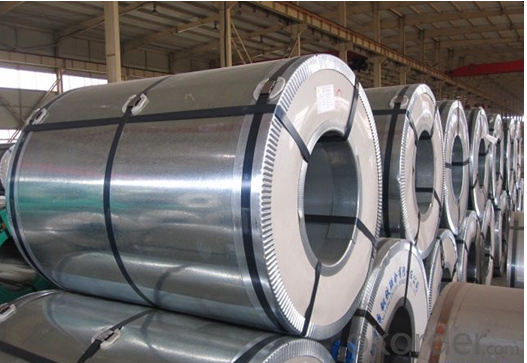

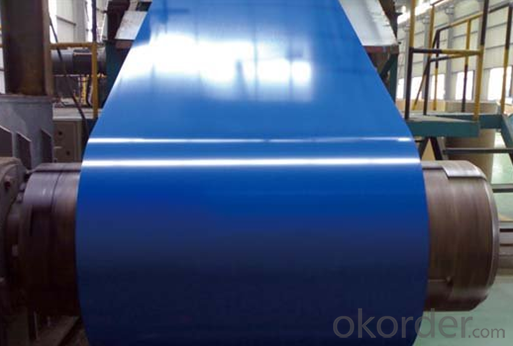
FAQ
1. What's your normal delivery time?
Our delivery time about 10-20days for standard sizes, if you have other requirements like hardness and width ,it is about 20- 40days. But don't worry ,we also try our best for the delivery time ,because time longer and our cost is higher.
2.Are the products tested before shipping?
Yes, all of our PPGI and GI was qualified before shipping. We test every batch every day.
3. Is the sample available?
Yes, samples can be sent for test if you need.
- Q: What is the lifespan of steel coils?
- The lifespan of steel coils can vary depending on various factors such as the quality of the steel, its usage, maintenance, and environmental conditions. However, with proper care and maintenance, steel coils can typically last for several decades.
- Q: How are steel coils used in the manufacturing of mining equipment?
- Steel coils are used in the manufacturing of mining equipment to provide strength and durability to crucial components such as chassis, buckets, and structural frameworks. These coils are formed into various shapes and sizes, then welded or bolted together to create robust and reliable machinery capable of withstanding the harsh conditions and heavy loads encountered in mining operations.
- Q: If rail ties were melted, would they be like any other type of steel?
- If you were to melt rail steel down and pour it into ingots, I doubt anyone would check to find it's source although a skilled metalurgist would know. While the steel was melted you could toss a handful of old horseshoes in and change the composition and no one would know. Good luck with your project, I would like to know how it turns out.
- Q: I received a very nice set of stainless steel cookware as a wedding gift. While very pretty, Im finding them almost useless for cooking. Everything sticks, they're difficult to clean, and Im using my old non-stick pans instead. Should I simply leave the stainless out for decortive purposes, or are stainless steel pans better for some applications?
- Stainless steel has some benefits: 1) Dishwasher safe: my anodized aluminum pots are NOT dishwasher safe (my wife put one in and it lost its gun-metal gray finish - sad) 2) Conductivity: most stainless steel cookware has an aluminum (or copper) middle - this transfers the heat nicely - steel by itself does not conduct heat evenly. All Clad cookware refers to the fact that the aluminum within the cookware is clad in steel. 3) Aesthetics: stainless is pretty. Stainless is not anti-stick, so you'll have to use all your skills to avoid sticking. 1) Use oil or butter: heat your pan before oiling. Once to temp, add the oil/butter and wait for it to heat-through. THEN add your food - sticking should be minimized. 2) Move your food around a lot: once you add a piece of food that is likely to stick, move it shortly afterward. This will prevent the food from gluing itself to one spot in the pan - a crust will start to appear, and that will protect the food from sticking. 3) Love the fond: anti-stick pans don't have a good chance at fond development (fond is the stuff that sticks to the bottom of the pan, and is crucial to pan sauce creation). You should experiment with your cookware, or send it to me: I am wishing for some new cookware.
- Q: How are steel coils used in the manufacturing of automotive accessories?
- Due to their strength, durability, and versatility, steel coils find widespread use in the manufacturing of automotive accessories. These coils act as the primary raw material for various components and parts utilized in the automotive industry. One notable application of steel coils in automotive accessory production involves the creation of body panels and frames. These coils are shaped and formed according to desired specifications, and subsequently undergo cutting, stamping, and welding processes to fabricate the body panels and frames of vehicles. The exceptional strength of steel coils ensures that the resulting body panels and frames possess the necessary robustness to endure daily use and provide structural integrity to the vehicles. Moreover, steel coils are also employed in the production of automotive suspension systems. Specifically, coil springs, which constitute integral elements of the suspension system, are commonly fashioned from steel coils due to their capability to absorb and distribute the weight and impact of the vehicle. By supplying essential support and shock absorption, these coil springs contribute to a smooth and comfortable ride. Furthermore, steel coils are utilized in the manufacturing of various automotive accessories like exhaust systems, brackets, and other components. These coils are shaped and formed into the desired designs, and subsequently undergo cutting, bending, and welding procedures to fabricate these accessories. The strength and durability of steel render these accessories capable of withstanding high temperatures, vibrations, and other harsh operating conditions. In conclusion, the utilization of steel coils plays a pivotal role in the manufacturing of automotive accessories. Their provision of necessary strength, durability, and versatility facilitates the production of various components and parts. From body panels to suspension systems and accessories, steel coils significantly contribute to the overall quality, performance, and safety of automotive accessories.
- Q: How are steel coils inspected for straightness?
- Steel coils are typically inspected for straightness using various methods such as visual inspection, laser measurement, or by passing the coils through straightening equipment.
- Q: What are the different methods of edge trimming steel coils?
- There are several methods for edge trimming steel coils, including shearing, slitting, laser cutting, and milling. Each method has its own advantages and is chosen based on factors such as the desired precision, speed, and cost-effectiveness of the trimming process.
- Q: How are steel coils unloaded from a truck or ship?
- Steel coils are typically unloaded from a truck or ship using specialized equipment such as cranes, forklifts, or coil lifters. The coils are carefully lifted off the truck or ship and then placed onto a designated area in the storage yard or warehouse using the appropriate machinery.
- Q: How are steel coils used in the production of roofing panels?
- To manufacture roofing panels, steel coils are indispensable. These coils, usually composed of galvanized or coated steel, serve as the fundamental material for producing robust and top-notch roofing panels. Initially, the steel coils undergo a sequence of operations in a production facility. These operations involve flattening, cleaning, and shaping the coils to achieve the desired dimensions and profiles for the roofing panels. This process guarantees that the steel coils possess uniform thickness and are devoid of any impurities or flaws that could compromise the final product's integrity. Once the steel coils are prepared, they are fed into a roll forming machine. In this machine, the coils are gradually bent and shaped into the specific design and size required for the roofing panels. The roll forming process imparts the panels with their distinct corrugated or standing seam profiles, which enhance their strength and ability to withstand various weather conditions. After the roll forming process, the steel coils are divided into individual roofing panels of the desired length. These panels then undergo further processing to incorporate additional features, such as coatings or finishes, to enhance protection against corrosion and improve aesthetic appeal. Protective layers, such as zinc or paint, are often applied to the steel coils to enhance their resistance to rust, UV rays, and other environmental factors. Lastly, the roofing panels are packaged and transported to construction sites or distributors for installation. The utilization of steel coils in the production of roofing panels ensures that the final product is sturdy, long-lasting, and capable of withstanding heavy loads, strong winds, and other external forces. Steel is renowned for its high tensile strength, making it an ideal material for creating durable roofing panels. In conclusion, steel coils play a vital role in the production of roofing panels. Through a series of manufacturing processes, they are transformed into the desired dimensions and profiles, ensuring consistency and quality. The resulting roofing panels are not only visually pleasing but also highly resilient, providing superior protection and longevity for buildings.
- Q: What are the challenges in welding steel coils?
- In order to guarantee successful and high-quality welds, it is necessary to address various challenges encountered when welding steel coils. One primary challenge involves achieving appropriate joint preparation. Steel coils often exhibit different surface conditions, such as rust, scale, or oil, which must be cleaned or eliminated before welding. This demands extensive cleaning and preparation to establish a clean and reliable welding surface. Another challenge lies in controlling the heat input. Due to the thin nature of steel coils, excessive heat can result in distortion, warping, or even burn-through. Welding operators must exercise careful control over the heat input to prevent such issues and uphold the integrity of the coils. Additionally, the presence of residual stresses poses a significant difficulty. Steel coils typically endure various stresses during the manufacturing, transportation, and handling processes, which can lead to distortion or cracking during welding. To mitigate these stresses and prevent potential defects, sufficient preheating and post-weld heat treatment may be necessary. Ensuring proper weld penetration is also of utmost importance. Steel coils often possess varying thicknesses, making it challenging to achieve consistent and adequate weld penetration throughout the joint. Welding operators must select appropriate welding parameters and techniques to guarantee complete fusion and a robust bond. Lastly, the size and weight of steel coils can create logistical challenges during welding. Specialized equipment and precise positioning are required to handle large and heavy coils, ensuring safe and efficient welding. Additionally, the length of the coils may necessitate multiple passes or continuous welding, demanding skilled operators and meticulous coordination. In conclusion, welding steel coils necessitates careful attention to joint preparation, heat control, stress relief, weld penetration, and logistical considerations. Overcoming these challenges guarantees the production of welded steel coils that are of high quality and durability.
Send your message to us
Pre-Painted Color Coated Galvanized Steel Coils/Sheet
- Loading Port:
- China main port
- Payment Terms:
- TT OR LC
- Min Order Qty:
- 25 m.t.
- Supply Capability:
- 100000 m.t./month
OKorder Service Pledge
OKorder Financial Service
Similar products
Hot products
Hot Searches
Related keywords
